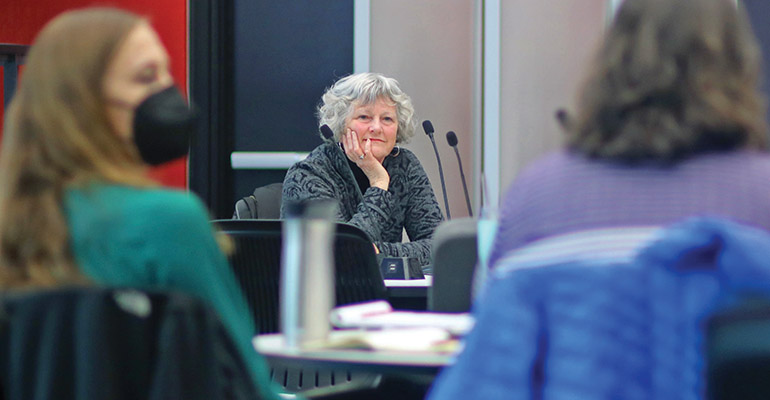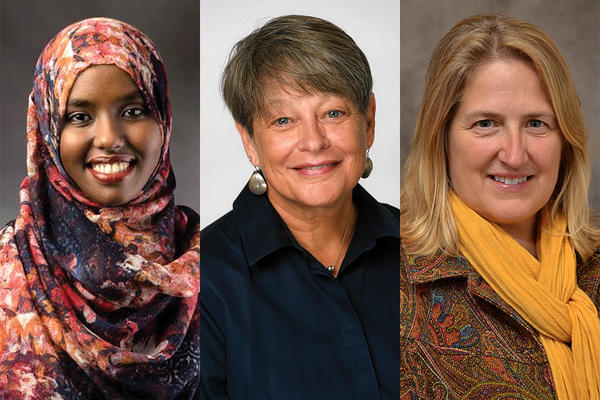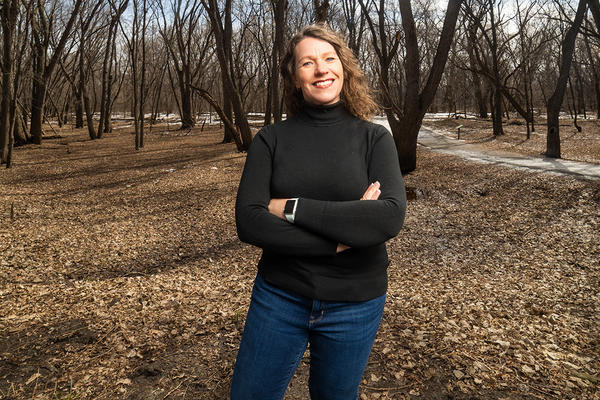Nursing our planet back to health
Planetary health curriculum links planet’s health to human health
May 6, 2022
Deane Morrison

As the inaugural director of Planetary Health for the School of Nursing, Teddie Potter is leading the effort to integrate planetary health curriculum throughout all of the school’s programs.
To Teddie Potter, there’s nothing revolutionary about health measures that target the whole world.
“Planetary health is an ancient way of understanding things,” says Potter, PhD, RN, FAAN, FNAP, clinical professor and director of Planetary Health. “It was Indigenous people who understood how all things were interconnected and that they couldn’t have a healthy community if the environment wasn’t healthy.”
Since 2015, the transdisciplinary field of planetary health has been gaining momentum, driven by its view of Earth as one interconnected ecosystem. It champions measures to protect, for example, oceans, the atmosphere, and forests that have kept the balance of nature on which all life depends. The School of Nursing and Potter are both members of the international Planetary Health Alliance, and she serves on its steering committee.
Potter, who with faculty introduced planetary health into the nursing curriculum, describes it as a paradigm that takes into account environmental conditions that don’t necessarily involve diseases, such as the glut of plastics in the ocean, the widespread loss of pollinators, land use changes, and the breakneck pace at which humanity—especially in affluent societies—consumes natural resources.
And then there’s climate change. Potter has been sharing the message about the danger since 2005. Today, models point to climate change as a major factor in the California wildfires that send smoke to Midwestern skies. Yet on a day when Potter said Minneapolis’ particulate matter index was five times what the World Health Organization says is safe, she expressed optimism that with effort, our species can remedy the problems it’s created.
“We need to make changes everywhere,” she says. “It will take massive innovation and massive collaboration. That’s what excites me about being at a university—we’ve got it all … experts in all of this and tremendous potential to innovate. If we can use fear and concern to help us innovate and collaborate, then the future looks very positive.”
Nursing: a force for change
A key goal of planetary health is “getting people to work together on a shared vision of moving toward a healthy planet,” Potter explains.
She coordinates the health innovation and leadership (HIL) specialty in the Doctor of Nursing Practice (DNP) program, which welcomes many students to the U of M from outside Minnesota “because they want to redesign the system,” she says.
“Young people are looking for a beacon of hope, that somebody’s working on these issues,” Potter notes. “I think the University is leading in this particular area.”
In 2018 Potter contacted Project Drawdown, a nonprofit dedicated to drawing down atmospheric levels of greenhouse gases, and argued that nurses—“the largest global health profession and the most trusted profession”—were well positioned to bring science-based solutions that address climate change to the general public.

Planetary Health Director Teddie Potter listens to a discussion about decarbonizing health care during the second annual Planetary Health Lectureship.
In partnership with Project Drawdown, nurses Katie Huffling (a graduate of the HIL DNP specialty) and Cara Cook from the international Alliance of Nurses for Healthy Environments (ANHE) and others worked with Potter to create Nurses Drawdown. In addition to the three founders, DNP students Tucker Annis and Claire Phillips also served on the planning committee.
Launched in June 2020, Nurses Drawdown helps nearly 1,000 nurses worldwide put planetary health principles into practice in the realms of energy, gender equity, food, mobility, and nature. Huffling, a nurse/midwife and ANHE’s executive director, wrote her DNP scholarly project on the initiative.
“While working on my master’s in nursing, there was a growing body of research about how fetal exposure to environmental toxins can have lifelong health impacts,” Huffling says. “They’re being linked to chronic conditions like diabetes and obesity. I didn’t see how I could do my job without seeing to this.”
Ground-level climate action
Over the years, Huffling has shifted her focus more to climate change, a major focus of the planetary health movement. Through Nurses Drawdown, she and her colleagues are educating nurses about solutions to climate-related health problems.
Actions need not be big and public. They include actions to do at home, such as switching to biking or public transportation and signing up for solar and wind power. They also include steps nurses can take in a healthcare or community setting, or by getting engaged in policy.
“And there’s much research about the benefit of planting trees,” Huffling adds. “Nurses have been leading tree-planting efforts, and communities with more trees have better health outcomes. Nurses are the largest portion of the health care workforce, so … getting just a small percentage engagement, we can start to make some shifts.”
According to polling research, the most effective way to frame the need for climate action is to connect it to health, Huffling says.
Provider taking a pulse of a child patient
“Even in parts of the country where climate change is not a good word, there are lots of opportunities for nurses to help their patients make the connection,” she notes.
For example, if a child has asthma and hot days—when air quality is poorer—are more frequent, the nurse may advise the mother not to idle her car and to look at where her energy is coming from.
Huffling has also cared for women with asthma during pregnancy, when the attacks can worsen. She may talk to those patients about how to prevent them, and why both the attacks and the weather events that aggravate them are more common now.
“I think patients are interested in this kind of information,” she says. “In pregnancy, mothers want to do what they can for the infant’s health.”
As the scope of their work widens, Huffling and Potter are encouraged by seeing people planting pollinator gardens, educating kids, keeping them in school and motivated, and showing them they can contribute to a better future.
“I believe this new way of thinking will lead us on a path that will be sustainable,” Potter says. “And [we’ll have] not illness, but health as an economic driver.”


